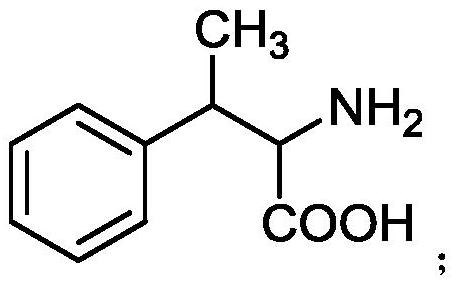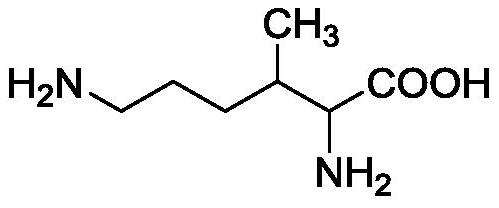Application of 2-amino-3-phenylbutyric acid or 2, 6-diamino-3-methylhexanoic acid as plant immune resistance inducer
An immune inducer, phenylbutyric acid technology, applied in the application field of plant immune inducer, can solve the problems that do not involve the research, report and patent of natural products and plant immune inducer activity, and achieve simple biological extraction , the effect of simple structure
- Summary
- Abstract
- Description
- Claims
- Application Information
AI Technical Summary
Problems solved by technology
Method used
Image
Examples
Embodiment 1
[0051] Embodiment 1 (biological synthesis, extraction method and structural identification of the compound of the present invention)
[0052] (1) Cultivation of Alternaria
[0053] Glucose sodium nitrate medium: glucose, 40.0g; NaNO 3 , 1.0g; NH 4 Cl, 0.25g; KH 2 PO 4 , 1.0g; KCl, 0.25g; NaCl, 0.25g; MgSO 4 ·7H 2 O, 0.5g; FeSO 4 ·7H 2 O, 0.01g; ZnSO 4 ·7H 2 O, 0.01g; yeast extract, 1g, add water to 1L, adjust pH to 5.5.
[0054] The Alternaria culture method is as follows: PDA medium activates the preserved strains, and after 7 days, select colonies with consistent growth, take a 5mm diameter bacterial cake, and inoculate it into 500mL medium, and the inoculation amount is one bacterial cake per 100mL. Place the medium inoculated with the bacterial blocks into a constant temperature shaker, and the culture conditions are: 140 rpm, 25°C, and dark culture for 7 days.
[0055] (2) Extraction of compounds
[0056] The mycelia were separated from the fermentation broth ...
Embodiment 2
[0069] Example 2 (2-amino-3-phenylbutyric acid and 2,6-diamino-3-methylhexanoic acid induce tobacco resistance to tomato spotted wilt virus infection)
[0070] Tomato spotted wilt virus was obtained from Yunnan Province, China. The initial source of the virus was stored in a -80°C refrigerator. The friction inoculation method was used to inoculate it on the leaves of Nicotiana benthamiana to activate the virus. The virus plasmid was extracted and transformed into Escherichia coli competent cells. , smeared on a resistant plate and cultured, picked a single colony for PCR screening, selected positive colonies for sequencing and subsequent plasmid extraction, added the plasmids with normal sequencing to Agrobacterium competent cells, and used the electric shock method for Agrobacterium For transformation, the transformed Agrobacterium liquid was spread on the corresponding resistance screening plate, and cultured at 28°C (±1) for 48h. Pick a single colony of Agrobacterium on the...
Embodiment 3
[0088] Example 3 (2-amino-3-phenylbutyric acid and 2,6-diamino-3-methylhexanoic acid induce wheat resistance to powdery mildew infection)
[0089] 2-Amino-3-phenylbutyric acid was dissolved in distilled water and then gradually diluted with distilled water to form 10nM, 100nM, 1000nM and 10000nM solutions, and a blank control was also set up. Wheat (NAU0686) seeds were germinated, planted in sterilized soil cultivation pots, and placed in a greenhouse at 23(±1)°C for 12h under light for cultivation. When the seedling grows to 1 leaf and 1 heart stage: the wheat seedlings are sprayed with stems and leaves with the 2-amino-3-phenylbutyric acid solution of the above-mentioned concentration, and the treatment is repeated once in 24 hours at intervals, and two treatments are carried out altogether. After 24 hours, fresh powdery mildew spores were evenly sprinkled on the wheat leaves, with 3 pots per treatment, 20 plants per pot. After 10 days, investigate the wheat disease level o...
PUM
 Login to View More
Login to View More Abstract
Description
Claims
Application Information
 Login to View More
Login to View More - R&D
- Intellectual Property
- Life Sciences
- Materials
- Tech Scout
- Unparalleled Data Quality
- Higher Quality Content
- 60% Fewer Hallucinations
Browse by: Latest US Patents, China's latest patents, Technical Efficacy Thesaurus, Application Domain, Technology Topic, Popular Technical Reports.
© 2025 PatSnap. All rights reserved.Legal|Privacy policy|Modern Slavery Act Transparency Statement|Sitemap|About US| Contact US: help@patsnap.com



